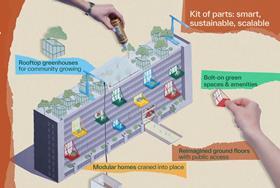www.informationweek.com
Vendor relationships have been changing over the years, with more vendor organizations becoming consultative in nature. For decades companies have been adding a service arm to expand their share of wallet, a KPI that doesnt necessarily benefit customers. The ultimate test of a vendors value is the business value realized as the result of the partnership.Vendor relationships are more important than ever before, says AJ Thompson, chief commercial officer at IT consultancy any Northdoor. With technology solutions now so complex and constantly changing, he says you can't underestimate how important solid relationships between organizations and vendors have become. This is true in several ways. Tech is getting more complicated by the day, so vendors who really know their stuff are worth their weight in gold. They share knowledge and provide the support you just can't get elsewhere.One of the big benefits of a strong vendor relationship is that enterprises get early access to new technologies and features, which helps chief information officers stay current. Its also important to have trustworthy vendors that maintain decent security and compliance amid increasingly complex regulatory landscapes.When youve found good relationships, you end up with solutions that actually fit your needs and more wiggle room during implementation, says Thompson. Plus, when things go wrong -- and they always do -- problems get sorted much faster when you're on good terms.Related:Trust is the necessary foundation, which is built through open communication, solid performance, relevant experience, and proper security credentials and practices. [P]eople buy from people they trust, no matter how digital everything becomes, says Thompson. That human connection remains crucial, especially in tech where you're often making huge investments in mission-critical systems.For example, when Northdoor was implementing a complex solution for a client with an extremely tight deadline and hit a snag, its primary vendor's account manager brought in the senior engineering team within hours to resolve the issue.[That account manager] knew our business well enough to understand the stakes and trusted us when we emphasized the urgency, says Thompson. That kind of responsiveness simply doesn't happen with transactional vendor relationships. In fact, the client later mentioned that watching how our vendor partner responded during that crisis gave them more confidence in our overall solution than any sales presentation could have.Related:AJ Thompson, NorthdoorThats why Thompson invests significant time in regular face-to-face meetings with Northdoors key vendors discussing products and roadmaps and the people behind them.Vendors who don't hide their limitations and are upfront about their capabilities tend to earn trust quickly. Meeting SLAs consistently matters enormously, says Thompson.Those who [understand] the specific challenges of your industry are gold dust, particularly in IT and cybersecurity where proper security practices and the right certifications make all the difference to confidence levels.Ashish Malhotra, president at management advisory firm Ampalyst Advisors, says selecting a vendor and executing a professional services agreement is relatively straightforward, but getting it wrong is prohibitively expensive.In todays dynamic technology landscape, vendor selection is more critical than ever, says Malhotra. As companies increasingly favor a buy over build approach, choosing the right vendors becomes paramount.Vendors can provide significant value in several ways, such as providing access to global talent and ecosystems, having the flexibility to scale resources up or down as needed, and shifting human capital from fixed to variable costs.Related:Vendors can also help their customers address in-house skills gaps and reduce managerial overhead costs. Importantly, customers can benefit from the industry expertise gained from multiple client engagements and innovative problem-solving approaches while ensuring adherence to proven methodologies and upskilling internal staff in emerging technologies. However, most important of all is trust.Trust is fundamental in partnerships, but in customer-vendor relationships, it must be paired with verification. Third-party governance is a critical function that should remain independent of the outsourcing arrangement, says Malhotra. Yet, many organizations make the mistake of allowing vendors to self-govern through dashboards, report cards, and operational meetings leading to weakened oversight.An executive-level technology governance framework helps ensure effective vendor oversight. According to Malhotra, it should consist of five key components, including business relationship management, enterprise technology investment, transformation governance, value capture and having the right culture and change management in place.Beneath the technology governance framework is active vendor governance, which institutionalizes oversight across ten critical areas including performance management, financial management, relationship management, risk management, and issues and escalations. Other considerations include work order management, resource management, contract and compliance, having a balanced scorecard across vendors and principled spend and innovation.Vendors that excel in these areas build greater trust, says Malhotra. Trust is not an abstract concept -- it is measurable through quantifiable performance indicators.Igor Epshteyn, president and CEO at digital product engineering company Coherent Solutions, believes as AI, cybersecurity, and compliance requirements are growing more complex, cooperating with a trusted vendor means having a partner who can provide up-to-date solutions.For businesses cooperating with IT vendors, it is crucial to choose digital engineering partners who have a proven track record and recommendations and, importantly, can guarantee strong cybersecurity measures, says Epshteyn.The Biggest Mistakes Vendors MakeOne of the biggest mistake vendors make is failing to drive tangible value for customers. Instead, the relationship is more transactional in nature, with the goal of upselling and cross selling products or solutions regardless of how the implementation will likely playout in the long term.Over-promising and under-delivering, poor communication, being stuck in their ways or vanishing after the sale absolutely kill trust and damage relationships beyond repair, says Northdoors Thompson. Vendors who refuse to adapt to changing needs are a write-off, and those who focus too much on closing deals rather than providing ongoing support won't keep clients for long.Ampalysts Mahotra says one of the biggest mistakes vendors make is bundling their services into rigid, all-inclusive packages that customers cannot easily modify. This includes offering a 2% innovation credit that customers do not know how to utilize, embedding proprietary portals and tools that cannot be decoupled if the customer terminates the contract and structuring contracts that lock customers in rather than fostering loyalty through performance.Ashish Malhotra, Ampalyst AdvisorsWhile [bundled services] are marketed as value-adds, they often function as exit constraints. As customers mature in their procurement strategies, they prefer vendors who win future business through high net promoter scores and strong performance -- not those who rely on contractual entrapment, says Malhotra. He says that while customers must ensure vendors are not earning excessive margins, sustainable partnerships require vendors to maintain healthy profitability. A well-structured engagement should be mutually beneficial rather than a race to the lowest cost.Coherent Solutions Epshteyn says missteps in communication, unresponsiveness, and overpromising are quite common.Clients should receive regular feedback, and their issues should be addressed as soon as possible by a dedicated account manager, says Epshteyn. Vendors who aim to build long-term and trustworthy partnerships should make sure they deliver on their promises, set clear deadlines, and are transparent about challenges and changes.How CIOs Should Approach Vendor RelationshipsNorthdoors Thompson says CIOs should do their homework on both a vendors technical capabilities and how they treat their customers.Set clear expectations and measurable KPIs from day one so everyone's on the same page. Schedule regular reviews to keep things on track and nip problems in the bud, says Thompson. Try to create genuine partnerships rather than just transactions. Where appropriate, get vendors involved in strategic discussions [because] it leads to much better outcomes. And finally, put real time and effort into nurturing key vendor relationships. Theyre strategic assets that pay off tremendously.Ampalysts Malhotra says vendor selection should involve both threshold and comparative criteria. The threshold criteria are binary conditions that vendors must meet to be considered. Missing any of them should preclude a vendor from further evaluation. These criteria may involve environmental factors like political and social stability where the vendor operates, legal protections including robust regulatory frameworks and IP security, and company-specific requirements such as minimum revenue size, relevant domain expertise, compliance with industry regulations and talent availability.Once vendors meet the threshold criteria, they should be assessed using a ratings-based approach that considers the infrastructure and technology ecosystem, depth of talent and expertise, cost structure, and financial viability. Other important considerations include the labor pool size, literacy rates, and access to educational institutions as well as language and communication proficiency.Vendor selection is just the first step, says Malhotra. Managing these relationships is the companys responsibility and cannot be outsourced. This is where technology governance and third-party governance become essential in sustaining long-term, value-driven partnerships.As the tech landscape continues to evolve, strong vendor relationships become a critical differentiator.[Strong vendor relationships] not only help in navigating complex technological challenges but also drive innovation and create strategic value, saysThompson. By focusing on transparency, performance, and mutual growth, organizations can cultivate vendor relationships that significantly contribute to their success in the digital era."












